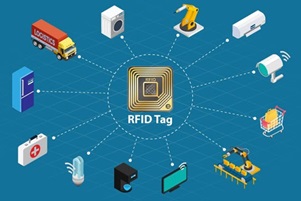
Increasing need for RFID systems in manufacturing units for improving productivity, increasing government initiatives and regulations for safety and security and rising need for improving inventory management for logistics and supply chain to drive the growth of the RFID market. The latest research shows that this market is projected to reach USD 40.9 billion by 2032 from USD 15.8 billion in 2023, and is expected to grow at a CAGR of 11.1% from now until 2032.
The RFID market has a promising growth outlook due to its increasing adoption across various industries. The research shows that with the integration of RFID into the Internet of Things (IoT) ecosystem and its expanding use in sectors such as healthcare and pharmaceuticals, retail, logistics, and manufacturing, the market is set to expand.
In 2022, the logistics and supply segment held the largest market share, and this pattern is expected to persist in the forecast period. The predominance of this sector can be attributed to the extensive adoption of tracking systems by logistics companies to monitor and oversee their cargo in transit.
Additionally, organisations are increasingly implementing sensor-based RFID tagging systems to oversee environmental conditions surrounding transported products. Any deviations in product attributes or external factors trigger notifications to relevant stakeholders, enabling timely action to prevent damage. RFID tags have proven invaluable to government authorities for asset monitoring and ensuring the legal flow of products.
These proactive measures against transit product loss have significantly bolstered the adoption of RFID tags in logistics and supply chain applications. This sector encompasses RFID tag usage in diverse applications, including postal and courier services, asset tracking, freight tracking, cargo monitoring, container tracking, and other supply chain operations.
RFID solutions can empower industries to optimise their supply chains by enhancing warehouse inventory management, shipment tracking, and route optimisation. Transitioning to an electronic and paperless environment via RFID technology allows suppliers and wholesalers to achieve inventory accuracy exceeding 99.9%, eliminating human errors. The use of RFID solutions enables the real-time maintenance of a comprehensive database, including information on warehouse stocks and products in transit.
In terms of value, label tags represent the largest share in the RFID tag market. Labels are the most prevalent, cost-effective, and widely employed tags, commonly affixed to assets in various settings such as IT parks, industrial materials, industrial equipment, data centre assets, hospital equipment, pharmaceuticals, and a multitude of other products and items.
Manufacturers typically supply labels in bulk as reel/bundle purchases. These tags are predominantly designed for single-use applications, resulting in their widespread use across various end-user industries. Some companies also offer durable, tear-resistant labels suitable for long-term and challenging environmental conditions. The extensive adoption of label tags across virtually every industry significantly contributes to market growth.
During the forecast period, the Asia Pacific region is poised to experience the most significant growth in the RFID tag market. In 2022, China held the largest share of the RFID tag market in the Asia Pacific. However, Japan is projected to exhibit the highest CAGR in the foreseeable future. Notably, the healthcare and retail sectors in Japan have been early adopters of RFID solutions. Moreover, the sports and entertainment industry in the region is demonstrating a growing interest in RFID technology. The presence of prominent baseball leagues in Japan and South Korea, coupled with various sports organisations and associations in Australia and New Zealand, is expected to drive RFID technology adoption in the sports sector.











